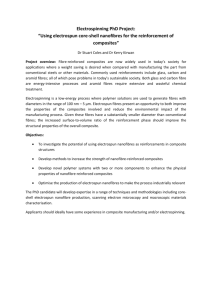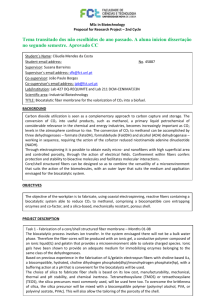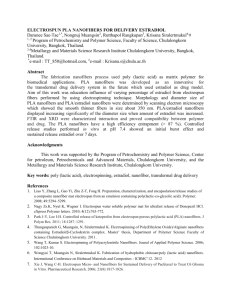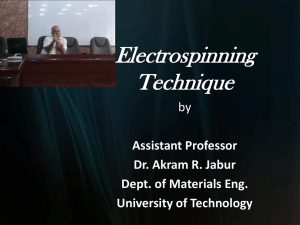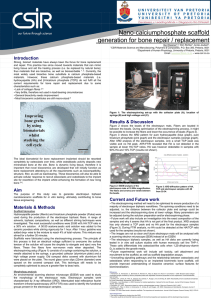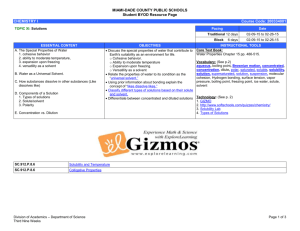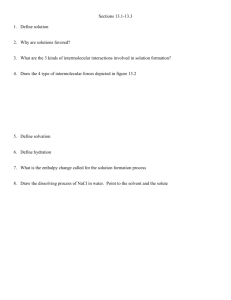MS Word
advertisement
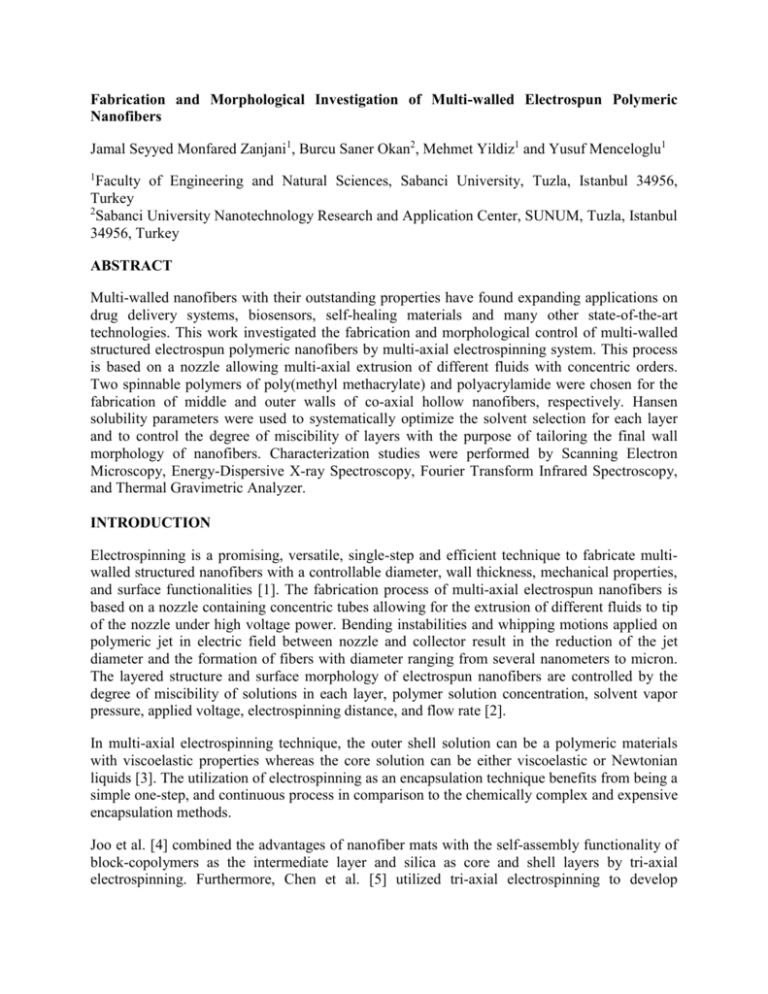
Fabrication and Morphological Investigation of Multi-walled Electrospun Polymeric Nanofibers Jamal Seyyed Monfared Zanjani1, Burcu Saner Okan2, Mehmet Yildiz1 and Yusuf Menceloglu1 1 Faculty of Engineering and Natural Sciences, Sabanci University, Tuzla, Istanbul 34956, Turkey 2 Sabanci University Nanotechnology Research and Application Center, SUNUM, Tuzla, Istanbul 34956, Turkey ABSTRACT Multi-walled nanofibers with their outstanding properties have found expanding applications on drug delivery systems, biosensors, self-healing materials and many other state-of-the-art technologies. This work investigated the fabrication and morphological control of multi-walled structured electrospun polymeric nanofibers by multi-axial electrospinning system. This process is based on a nozzle allowing multi-axial extrusion of different fluids with concentric orders. Two spinnable polymers of poly(methyl methacrylate) and polyacrylamide were chosen for the fabrication of middle and outer walls of co-axial hollow nanofibers, respectively. Hansen solubility parameters were used to systematically optimize the solvent selection for each layer and to control the degree of miscibility of layers with the purpose of tailoring the final wall morphology of nanofibers. Characterization studies were performed by Scanning Electron Microscopy, Energy-Dispersive X-ray Spectroscopy, Fourier Transform Infrared Spectroscopy, and Thermal Gravimetric Analyzer. INTRODUCTION Electrospinning is a promising, versatile, single-step and efficient technique to fabricate multiwalled structured nanofibers with a controllable diameter, wall thickness, mechanical properties, and surface functionalities [1]. The fabrication process of multi-axial electrospun nanofibers is based on a nozzle containing concentric tubes allowing for the extrusion of different fluids to tip of the nozzle under high voltage power. Bending instabilities and whipping motions applied on polymeric jet in electric field between nozzle and collector result in the reduction of the jet diameter and the formation of fibers with diameter ranging from several nanometers to micron. The layered structure and surface morphology of electrospun nanofibers are controlled by the degree of miscibility of solutions in each layer, polymer solution concentration, solvent vapor pressure, applied voltage, electrospinning distance, and flow rate [2]. In multi-axial electrospinning technique, the outer shell solution can be a polymeric materials with viscoelastic properties whereas the core solution can be either viscoelastic or Newtonian liquids [3]. The utilization of electrospinning as an encapsulation technique benefits from being a simple one-step, and continuous process in comparison to the chemically complex and expensive encapsulation methods. Joo et al. [4] combined the advantages of nanofiber mats with the self-assembly functionality of block-copolymers as the intermediate layer and silica as core and shell layers by tri-axial electrospinning. Furthermore, Chen et al. [5] utilized tri-axial electrospinning to develop nanowire-in-microtube nanofibers and obtained homogeneous or heterogeneous wire-in-tube one dimensional materials by removing the middle spacer layer. In addition, Liu et al. [6] fabricated gelatin/Poly(ε-caprolactone)/gelatin multi-layer nanofibers via tri-axial electrospinning technique to enhance mechanical properties of gelatin as a natural biodegradable and biocompatible polymer by a layer of synthetic Poly(ε-caprolactone) with fine mechanical properties. Tri-axial electrospun nanofibers were also designed as novel drug delivery systems by the combination of multiple drug molecules in core and shell of the fibers with different release time profiles [7]. In present work, multi-axial electrospinning technique was applied to fabricate co-axial hollow fibers by using different middle and outer wall materials. Hansen solubility parameters were used for systematical optimization of solvent selection for wall materials, and thus compatible wall solutions have prevented the diffusion of layers during electrospinning process. EXPERIMENT Materials Poly(methyl methacrylate) (PMMA, Mw=330000 Daltons), methyl methacrylate (SAFC, 98.5%), Azobisisobutyronitrile (AIBN, Fluka, 98%), acrylamide (Sigma, 99%), N,N Dimethylformamide (DMF, Sigma-Aldrich, 99%), methanol (Sigma-Aldrich, 99.7%), tetrahydrofuran (THF, Merck, 99%), dimethyl sulfoxide (DMSO, Sigma, 99%). Wall material synthesis PMMA as an outer wall material was synthesized by free radical polymerization of methyl methacrylate (30 ml) in presence of AIBN (1 g, initiator to monomer molar ratio of 2%) as the radical initiator in the medium of THF (50 ml) at 65°C. Polyacrylamide (PAAm) as a middle wall material was synthesized by dispersion polymerization of acrylamide monomer (30 gr) in methanol (100 ml) by using AIBN (1 g, initiator to monomer molar ratio of 1.5 %) as an initiator at 65°C. Solutions preparation for multi-axial electrospinning The outer layer solution was prepared by 20 wt% of PMMA in DMF. The middle wall solution contained 20 wt% PAAm in deionized water or a mixture of water and different solvents. Solutions were stirred for 24 h prior to electrospinning to obtain homogeneous solutions. Then, the prepared solutions were loaded independently into the concentric nozzles and each syringe pump controlled the flow rates. The electrospinning apparatus purchased from Yflow Company was used for electrospinning experiments. Characterization The surface morphologies of co-axial hollow fibers were analyzed by a Leo Supra 35VP Field Emission Scanning Electron Microscope (SEM). Elemental analysis of fibers was performed by using Energy-Dispersive X-Ray (EDX) analyzing system. The functional groups of each layer were investigated by Netzsch Fourier Transform Infrared Spectroscopy (FTIR). Thermal behaviors of fibers were examined by Netzsch Thermal Gravimetric Analyzer (TGA) by a 10°C/min scanning rate under nitrogen atmosphere. Samples were dried for 24 h at room temperature under vacuum to remove moisture and residual solvents before TGA analysis. DISCUSSION Solvent Selection Based on Hansen Solubility Parameters Miscibility and compatibility of solutions in multi-axial electrospinning process have great effect on final morphology of layers. Solutions with less miscibility lead to distinct wall formation whereas solutions with partial miscibility cause diffused wall morphology on final structure of the fibers [8]. Hansen Solubility Parameters (HSP) method is a powerful tool to control and monitor the compatibilities of solvent and solute using tabulated interactions of molecules in the form of polar (δp), dispersive (δd), and hydrogen bonding (δh) components [9]. Two-dimensional graphical representation of these parameters for our system was produced by combining the polar (δp) and dispersive (δd) components into a new parameter of δv = (δd2 + δp2)1/2 which was ploted against δh. Radius of interaction (R), HSP parameter, provides a solubility circle in two dimensional diagram and the solvents placed in this circle indicate the solubility of solute. In the case of PMMA as outer wall material, the coordinates of the center of the solubility circle are δv = 21.35 MPa1/2, δh = 7.5 MPa1/2 and the radius of interaction is 8.6 MPa1/2 (Figure 1a). Among the solvents located in the solubility circle of PMMA, DMF was one of suitable solvents for electrospinning process. Water as the main solvent of PAAm was used to prepare middle wall solution. Different cosolvents with various ratios were utilized to tailor the interaction of middle and outer wall solutions (Table I). The Hansen solubility parameter of solvent mixtures is calculated by using n Mix iai n i equation where n represents the parameter type (p, d, or h) and ai is the volume fraction of solvent i. The solubility map of PAAm was plotted regarding this equation in Figure 1b. In solubility map of PAAm, green points were soluble regions, yellow points were turbid solutions and red points were immiscible solvents. Figure 1. Two-dimensional (δv vs δh) diagrams of Hansen solubility parameters for various solvents and solvent mixtures (a) PMMA solubility and (b) PAAm solubility Table I. Hansen Solubility Parameters and solubility status of PAAm in different solvent systems Solvent system Code Ratio δd δp δv δh Solubility Water: DMF WD-4:1 4:1 15.9 15.5 22.3 36.2 Dissolved Water: DMF WD-3:2 3:2 16.3 15.0 22.2 30.1 Dissolved Water: DMF WD-2:3 2:3 16.7 14.6 22.2 24 Dissolved Water: DMF WD-1:4 1:4 17.0 14.1 22.1 17.9 Turbid solution DMF DMF - 17.4 13.7 22.1 11.8 Undissolved Water: Acetone WA-4:1 4:1 15.5 14.9 21.5 35.2 Dissolved Water: Acetone WA-3:2 3:2 15.5 13.7 20.8 28.2 Turbid solution Water: Acetone WA-2:3 2:3 15.5 12.6 20.0 21.1 Turbid solution with droplet Water: Acetone WA-1:4 1:4 15.5 11.5 19.3 14.1 Undissolved Acetone Acetone 1 15.5 10.4 18.7 7 Undissolved Water:Ethanol WE-4:1 4:1 15.6 16 22.3 42.3 Dissolved Water:Ethanol WE-3:2 3:2 14.6 21.4 37.7 Dissolved Water:Ethanol WE-2:3 2:3 15.6 4 15.6 13.1 20.4 33.1 Dissolved Water:Ethanol WE-1:4 1:4 11.7 19.6 28.5 Turbid solution Ethanol Ethanole 1 10.2 18.8 23.9 Undissolved Water:DMSO WDM-4:1 4:1 15.7 2 15.7 6 15.6 16 22.3 42.3 Dissolved Water:DMSO WDM-3:2 3:2 16.2 16.1 22.8 35.9 Dissolved Water:DMSO WDM-2:3 2:3 16.7 16.2 23.3 29.5 Dissolved Water:DMSO WDM-1:4 1:4 16.2 23.7 23.0 Dissolved DMSO DMSO 1 17.3 8 17.8 16.3 24.2 16.6 Undissolved Surface morphology of multi-walled electrospun fibers SEM images revealed the formation of electrospun co-axial hollow fibers produced by different pairs of solutions with different compatibilities in Figure 2. Figure 2a showed a sharp and smooth interface between middle and outer walls of the fibers prepared by PAAm in water as middle wall solution and PMMA in DMF solution as outer wall. On the other hand, this distinction between wall materials was not observed in Figure 2b and 2c because the same solvent was used in both middle and outer walls. The results showed that wall materials diffused each other during electrospinning process and the boundaries of walls disappeared when the compatibility of wall solutions increased. Figure 2. SEM images of electrospun co-axial hollow fibers with same outer wall solution (a) water as middle wall solvent and, (b) and (c) mixture of water/DMF (volume ratio 3:2) as middle wall solvent in different regions. Structural analysis of multi-walled electrospun nanofibers The formation of co-axial hollow fibers was observed by monitoring the functional groups. Figure 3 exhibited electrospun co-axial hollow fibers with PMMA as outer wall and PAAm as middle wall material. For PMMA polymer, absorption bands at 2950 cm-1 and 1745 cm-1 indicated C-H and C=O stretchings, respectively[10]. For PAAm polymer, asymmetric and symmetric NH stretchings of NH2 contributed to absorption bands at around 3300 cm−1 [11]. EDX results showed that co-axial hollow fiber included 56% carbon, 30% oxygen and 14% nitrogen. The nitrogen content in the fiber indicated the presence of PAAm in fiber structure. Figure 3. FTIR spectrum of electrospun co-axial hollow fiber with PMMA as outer wall and PAAm as middle wall Figure 4 exhibited TGA curves of PMMA and PAAm polymers and co-axial hollow fiber. The weight loss curve of co-axial hollow fibers appeared between PMMA and PAAm (Figure 4a). These three samples decomposed at approximately 400oC. The derivative of TGA curves also indicated the presence of two different polymers in the structure of co-axial hollow fiber having two distinct peaks due to PMMA and PAAm. As a result, TGA analyses proved the successful formation of co-axial hollow fibers during electrospinning process. Figure 4. (a) TGA curves of PMMA, PAAm and co-axial hollow fibers and (b) differential thermal analyses of PMMA, PAAm and co-axial hollow fibers. CONCLUSIONS This study showed an optimized and quantified procedure for solvent selection and morphological control in the fabrication of multi-axial electrospun fibers by using Hansen solubility parameters and solvent blending techniques. The distinction and diffusion of walls in the structure of fiber were tailored by changing solvent ratios in middle wall. The formation of electrospun co-axial hollow fibers with PMMA as outer wall and PAAm as middle wall was proved by both FTIR and EDX analyses. PMMA, a shell of electrospun fibers, provided a brittle structure allowing the breakage of layer. Consequently, these co-axial hollow fibers provide a great platform to apply different types of materials in wide range of applications such as catalysis, hydrogen storage, self-healing, water filtration and biomedical systems. ACKNOWLEDGMENTS The authors gratefully acknowledge financial support from the Scientific and Technical Research Council of Turkey (TUBITAK) Project No: 112M312/COST MP1202 and travel support from International Institute for Complex Adaptive Matter (I2CAM). REFERENCES [1] E. Ozden-Yenigun, E. Simsek, Y. Z. Menceloglu, and C. Atilgan, "Molecular basis for solvent dependent morphologies observed on electrosprayed surfaces," Physical Chemistry Chemical Physics, vol. 15, pp. 17862-17872, 2013. [2] M. M. Demir, M. A. Gulgun, Y. Z. Menceloglu, B. Erman, S. S. Abramchuk, E. E. Makhaeva, A. R. Khokhlov, V. G. Matveeva, and M. G. Sulman, "Palladium Nanoparticles by Electrospinning from Poly(acrylonitrile-co-acrylic acid)−PdCl2 Solutions. Relations between Preparation Conditions, Particle Size, and Catalytic Activity," Macromolecules, vol. 37, pp. 1787–1792, 2004. [3] K. H. K. Chan and M. Kotaki, "Fabrication and morphology control of poly(methyl methacrylate) hollow structures via coaxial electrospinning," Journal of Applied Polymer Science, vol. 111, pp. 408–416, 2009. [4] V. Kalra, J. H. Lee, J. H. Park, M. Marquez, and Y. L. Joo, "Confined Assembly of Asymmetric Block-Copolymer Nanofibers via Multiaxial Jet Electrospinning," Small, vol. 5, pp. 2323–2332, 2009. [5] H. Chen, N. Wang, J. Di, Y. Zhao, Y. Song, and L. Jiang, "Nanowire-in-Microtube Structured Core/Shell Fibers via Multifluidic Coaxial Electrospinning," Langmuir, vol. 26, pp. 11291–11296, 2010. [6] W. Liu, C. Ni, D. B. Chase, and J. F. Rabolt, "Preparation of Multilayer Biodegradable Nanofibers by Triaxial Electrospinning," ACS Macro Letters, vol. 2, pp. 466–468, 2013. [7] D. Han and A. J. Steckl, "Triaxial Electrospun Nanofiber Membranes for Controlled Dual Release of Functional Molecules," ACS Applied Materials & Interfaces, vol. 5, pp. 8241– 8245, 2013. [8] Z. Kurban, A. Lovell, S. M. Bennington, D. W. K. Jenkins, K. R. Ryan, M. O. Jones, N. T. Skipper, and W. I. F. David, "A Solution Selection Model for Coaxial Electrospinning and Its Application to Nanostructured Hydrogen Storage Materials," The Journal of Physical Chemistry C, vol. 114, pp. 21201–21213, 2010. [9] C. M. Hansen, Hansen Solubility Parameters: A User's Handbook, Second Edition Boca Raton, FL: CRC Press, 2007. [10] K. Kaniappan and S. Latha, "Certain Investigations on the Formulation and Characterization of Polystyrene/Poly(methyl methacrylate) Blends," International Journal of ChemTech Research, vol. 3, pp. 708-717, 2011. [11] R. Murugan, S. Mohan, and A. Bigotto, "FTIR and Polarised Raman Spectra of Acrylamide and Polyacrylamide," Journal of the Korean Physical Society, vol. 32, pp. 505-512, 1998.
